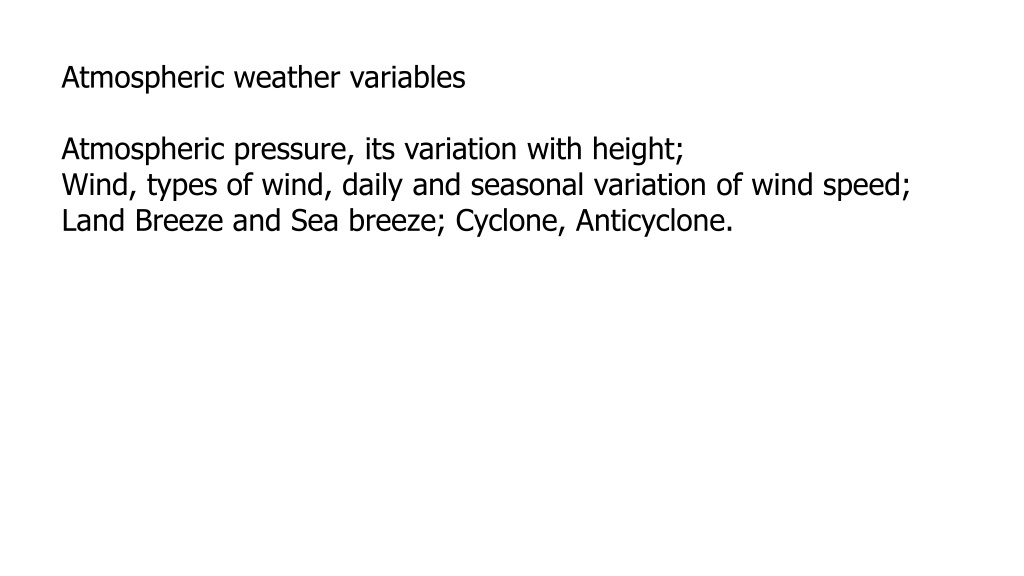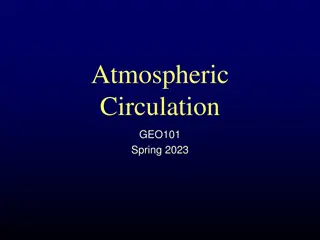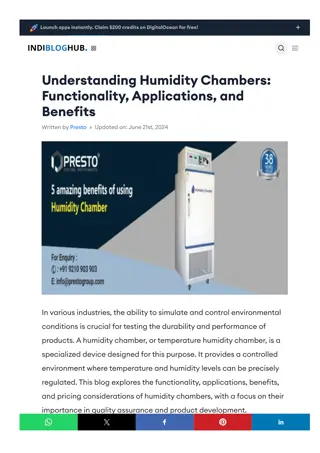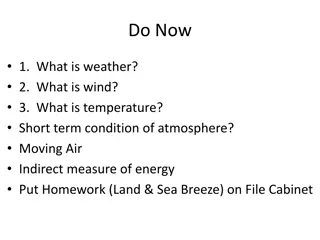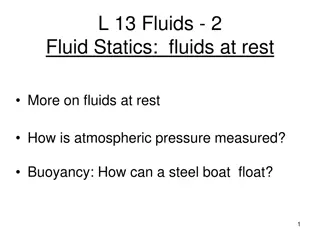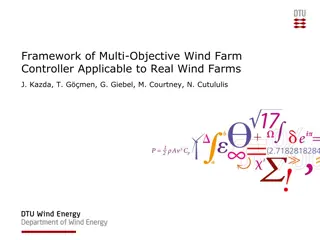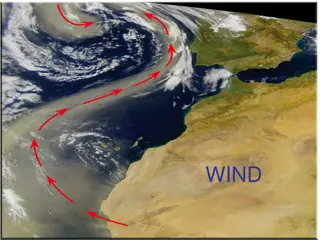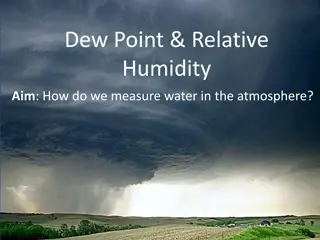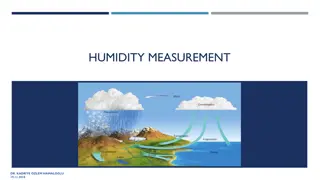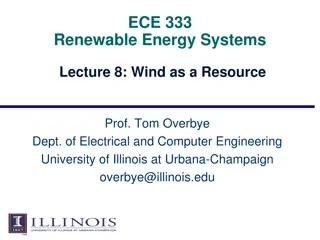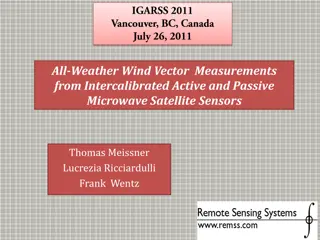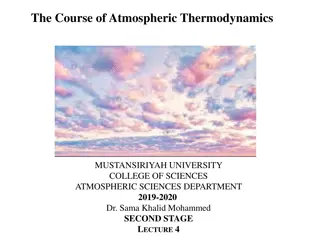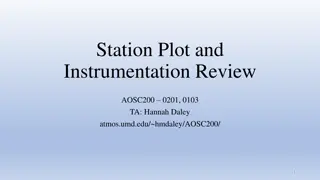Understanding Atmospheric Pressure, Wind Variations, and Humidity in Weather Systems
The atmosphere is composed of various elements like gaseous molecules, water vapor, and dust particles. Key weather variables include atmospheric pressure, temperature, humidity, wind, cloud cover, and precipitation. Atmospheric pressure is influenced by the weight of air above a point, with average sea-level pressure around 1.01 MPa. Humidity refers to the moisture content in the air, with water vapor playing a significant role in weather patterns. Terms like evaporation, vapor pressure, and latent heat are important in understanding atmospheric phenomena.
Download Presentation

Please find below an Image/Link to download the presentation.
The content on the website is provided AS IS for your information and personal use only. It may not be sold, licensed, or shared on other websites without obtaining consent from the author. Download presentation by click this link. If you encounter any issues during the download, it is possible that the publisher has removed the file from their server.
E N D
Presentation Transcript
Atmospheric weather variables Atmospheric pressure, its variation with height; Wind, types of wind, daily and seasonal variation of wind speed; Land Breeze and Sea breeze; Cyclone, Anticyclone.
Atmosphere: Composed of gaseous molecules, water vapour, dusts, aerosols etc. covering the earth over it s surface to thousand km. above. Weather: Characterization of atmosphere for a small area at a short span of time. Six Important weather variables: Atmospheric pressure Temperature Humidity Wind Cloud Cover Precipitation
ATMOSPHERIC PRESSURE Atmospheric pressure, sometimes also called barometric pressure, is the pressure exerted by the weight of air in the atmosphere of Earth. In most circumstances atmospheric pressure is closely approximated by the hydrostatic pressure caused by the weight of air above the measurement point. On average, a column of air one cm2 in cross-section, measured from mean sea level to the top of the atmosphere, has a mass of about 1.03 kg and weight of about 10.1 N. Average sea-level pressure is 1.01 MPa / 1 bar / 760 millimetres of mercury
Humidity: A general term that refers to moistness or dampness in the air. Humidity is the status on amount of water vapour present per unit volume of air mass. Atmospheric water vapour accounts only 1/1000th part of water present in the global hydrological cycle. Water vapour s affinity towards green house gases is the reason for it s major role in weather / climatic status of an area. Rate of evaporation/ transpiration regulates the status of humidity. Holding capacity of water vapour by air increases with an increase in air temperature.
Terminologies: Evaporation is a surface phenomenon where a liquid water transformed into vapour at a temperature below the boiling point of the liquid. Vapor pressure: In a mixture, every gas exert a partial pressure independent of other gases. The partial pressure exerted by water vapor is called vapor pressure. Actual / Saturated vapour pressure Condensation is a process where water vapor transformed into liquid. Latent heat of vaporization is defined as the heat required to change one mole of liquid at its boiling point under standard atmospheric pressure.
Latent heat of condensation is defined as the heat released when one mole of the substance condenses. The temperature does not change during this process, so heat released goes directly into changing the state of the substance. Latent heat of condensation of water is about 2,260 kJ/kg, which is equal to 40.8 kJ/mol. Latent heat of condensation is numerically exactly equal to the latent heat of vaporization, but has the opposite sign.
Various ways of expressing humidity ABSOLUTE HUMIDITY SPECIFIC HUMIDITY RELATIVE HUMIDITY HUMIDITY SATURATION MIXING RATIO MIXING RATIO VAPOUR PRESSURE
Vapour Pressure Vapor pressure is defined as the pressure exerted by the vapor present above the liquid. So, vapor pressure is nothing but the tendency of particles to escape from the liquid. Temperature is the sole factor that affects vapor pressure. At a room temperature if a substance has high vapor pressure, then it is referred to as volatile.
Characteristics of vapor pressure As time passes, the number of molecules in the vapor increases while the rate of condensation also increases. It reaches a stage where the rate of evaporation is equal to the rate of condensation. This phase is called the stage of equilibrium . At this point the pressure exerted by the molecules is called the vapor pressure of the liquid. The vapor pressure of a liquid is independent of the volume of liquid in the container.
Absolute Humidity is the ratio of the mass of water vapour to the total volume of the moist air. Mathematically, absolute humidity is defined as the mass of the water vapour (mv) divided by the volume of the air and water (mv+md) mixture, which is expressed as X = mv / Vmoist air = v = ev /RvT Thus absolute humidity is the density of water vapour and depends on the temperature (T) and vapour pressure (ev). Rv is the universal gas constant.
Specific humidity (q) is the ratio of mass of water vapour (mv) to that of the total mass (md + mv) of the moist air Mathematically it can be expressed as: q = mv/md +mv = 0.622ev/P - 0.378ev Where mv and md are the mass of water vapour and dry air. As ev <<P, ev can be neglected, Thus q 1/P Where P is the total pressure of the air.
Mixing Ratio () Mixing ratio is defined as the ratio of the mass of a variable atmospheric constituent (here water vapour) to the mass of dry air. Mathematically mixing ratio ( ) can be expressed as = mv/md =0.622.ev/P ev Where P is the total pressure of the air and ev is the pressure of water vapour.
Relative Humidity Relative humidity of air is defined as the ratio of the actual vapour pressure of air to its saturation vapor pressure at same air temperature level. So at any day RH depends on status of both water vapour and temperature. RH = (Pressure of water vapour present in the air at a temp. / Pressure of water vapour at maximum water holding capacity at that temp.) * 100% RH = ( / s)*100 = (ea / es)*100 and s are the actual mixing and saturation mixing ratio.
Dew Point Temperature The dew point is the temperature at which dew drops begin to form from water vapor. It is affected by pressure and water vapor content, which determine the temperature to which the air must be cooled in order for dew to form. The dew point is a saturation point, meaning that the air cannot receive any more water vapor. If the dew point temperature is below freezing, it is called the frost point.
Relationship between temperature and humidity Maximum amount of water vapor that a parcel of air can hold at a given temperature is called it s moisture holding capacity At any given point in time moisture holding capacity of air depends upon its temperature. The moisture increases with increasing temperature. Moisture holding capacity increases at faster rate at higher temperature than lower temperature. holding capacity
Dry bulb temperature The Dry Bulb temperature, usually referred to as air temperature, is the air property that is most commonly used. When people refer to the temperature of the air, they are normally referring to its dry bulb temperature. It is called "Dry Bulb" because the air temperature is indicated by a thermometer not affected by the moisture of the air. Dry-bulb temperature can be measured using a normal thermometer freely exposed to the air but shielded from radiation and moisture. The temperature is usually given in degrees Celsius (oC) or degrees Fahrenheit (oF).
Wet bulb temperature The wet bulb temperature is the temperature of adiabatic saturation. Wet Bulb temperature can be measured by using a thermometer with the bulb wrapped in wet muslin. The adiabatic evaporation of water from the thermometer and the cooling effect is indicated by wet bulb temperature The rate of evaporation from the wet bandage on the bulb, and the temperature difference between the dry bulb and wet bulb, depends on the humidity of the air. The wet bulb temperature is always lower than the dry bulb temperature but will be identical with 100% relative humidity (the air is at the saturation).
